The Hieroglyphic Stairway in Copán is a part of a large stepped Temple 26. Both the temple and the stairway had their prior, smaller versions, but they got their form visible today during the reign of ruler Smoke Shell around 755 CE.
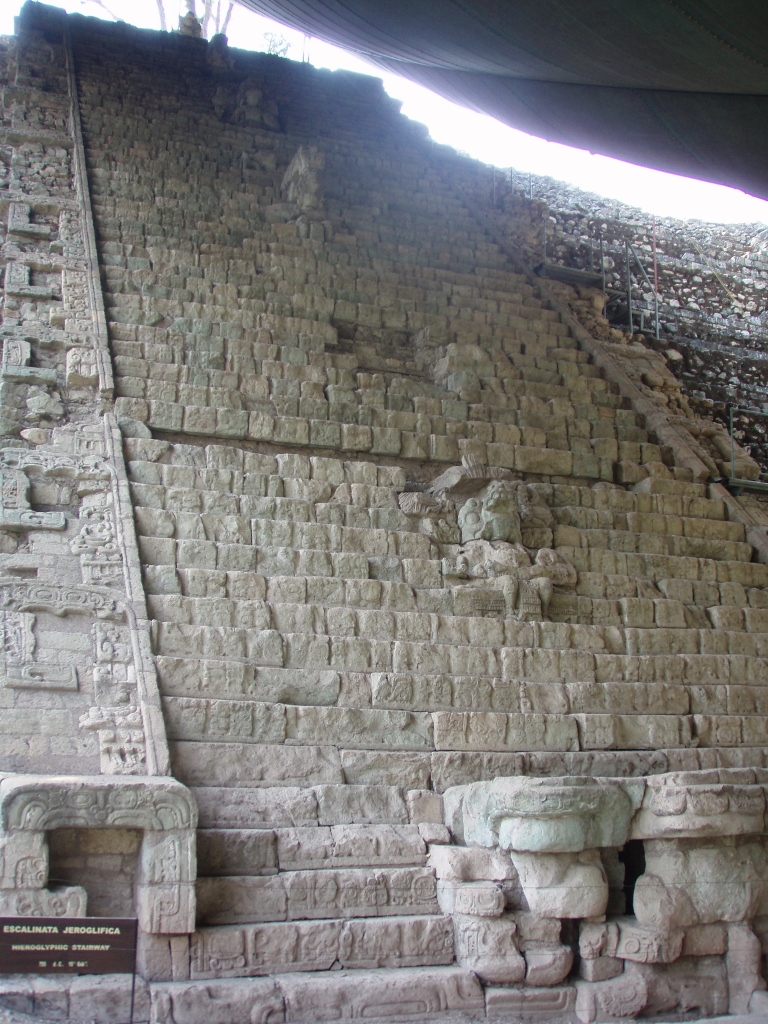 Hieroglyphic Stairway
Hieroglyphic Stairway
In order to protect it against the weather impacts, the entire stairways is nowadays protected by a large sloping canopy and this in a way spoils the views, but it is certainly better this way. When the researchers first started to work here only the first dozen of steps stood in their place and everything else had toppled, so it took a lot of hard work to reconstruct the stairway.
The stairway is 10 m wide and 21 m long, and it consists of 63 steps. Some data say that there are 62 steps, but I think that this aberration stems from the fact that at some point an American university worked on the reconstruction of the stairway and the agreement was that for their work they would be paid by one step (in other words, a 10 m long step, not one stone), so one step has apparently been taken away. As it may be seen in the photo above, at every dozen steps or so, in the middle, there are richly made sculptures that are presumed to be the depictions of the most important rulers from the Copán dynasty. However, what gives the true value to this stairway, including also its name, are over 2000 glyphs that exist on these stairs and this is the longest Mayan text that is known of and that conveys the story of the history of Copán from the 6th to the 8th century. Although it is quite pale, if one looks at the photo above more closely it is possible to see the glyphs that decorate the risers of the steps. The carved decorations and glyphs also exist on the ramps on both sides of the stairway.
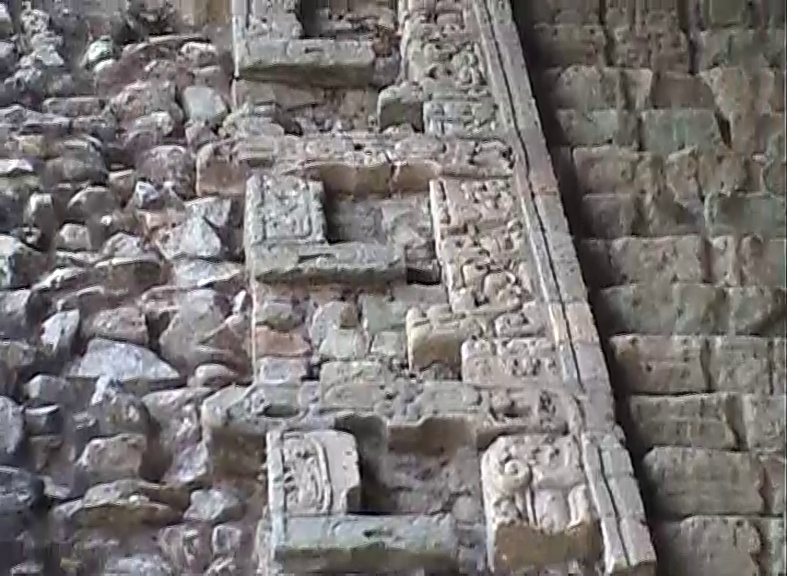 Detail of the ramp of the Hieroglyphic Stairway
Detail of the ramp of the Hieroglyphic Stairway
Although not everything has been interpreted to date, the value of this large a text is priceless. I have already written before about the Mayan script and the rare surviving documents (https://www.svudapodji.com/en/mesoamerica-2008-11/). This text written in the stone constitutes an important addition to the corpus of written documents that allow the researchers to come to important data on the past and culture of the ancient Maya.
At the bottom of the Hieroglyphic Stairway there is an altar for which the guidebooks claim that it depicts a (feathered) serpent from the mouth of which peers a human head, which is something I cannot see, but this certainly suggests the presence of the cult of Kukulkan, the deity that was sometimes shown precisely in this way – with open mouth from which protrudes the head of a warrior.
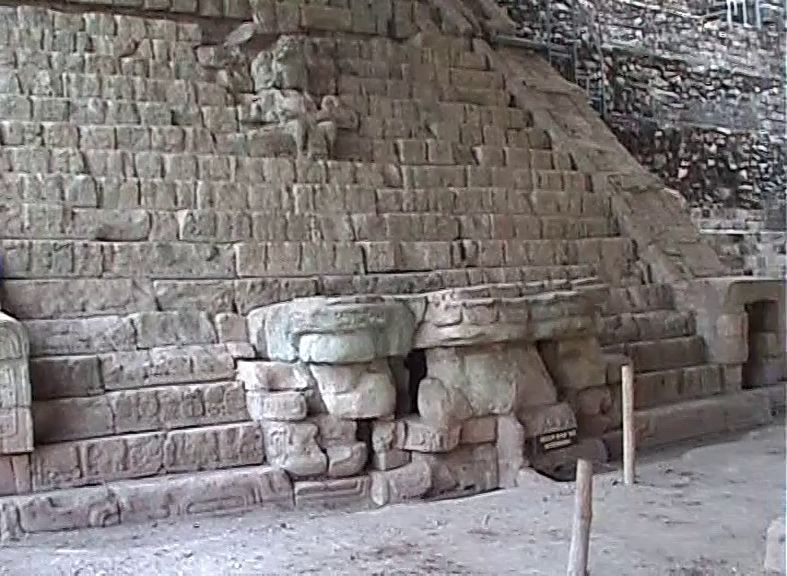 Altar at the bottom of the Hieroglyphic Stairway – I still cannot see either the serpent or the warrior here
Altar at the bottom of the Hieroglyphic Stairway – I still cannot see either the serpent or the warrior here
In front of the stairway and the altar, there is Stele M from 756 which shows ruler Kʼakʼ Yipyaj Chan Kʼawiil, that is, ruler Smoke Shell.
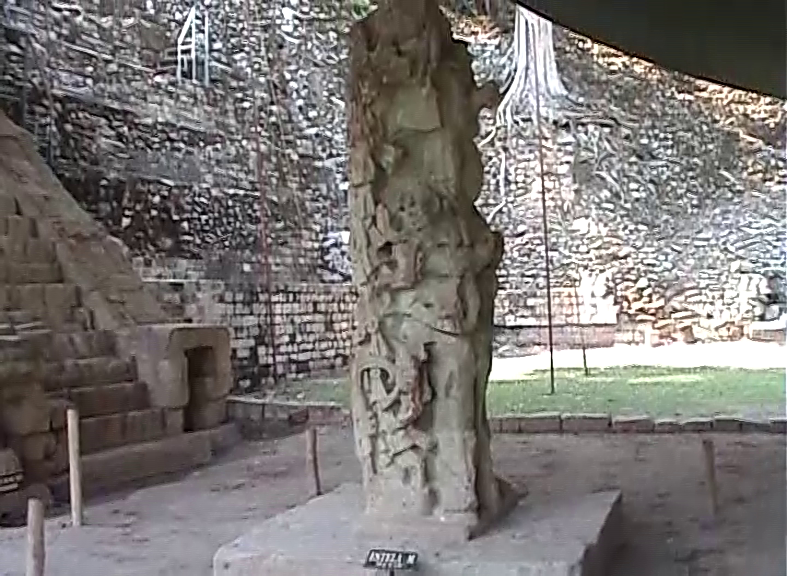 Stele M
Stele M
In the photo above it is also possible to see nicely how the stepped Temple 26 and a high pyramidal structure that constitutes Structure 11 are connected, i.e., how they extend one from the other at a right angle. It was precisely Structure 11, known also as the Temple of the Inscriptions, that was the next structure on my sightseeing tour.
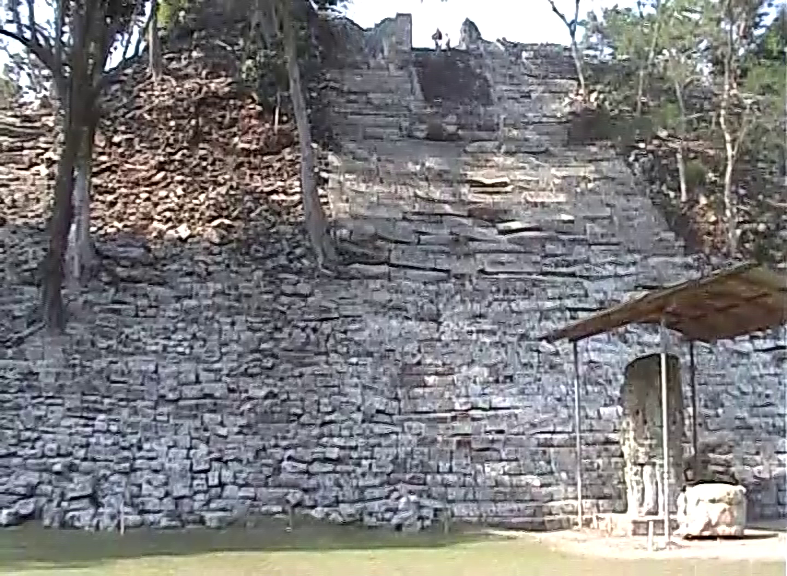 Structure 11 and Stele N in front of it
Structure 11 and Stele N in front of it
Stele N was dedicated in 761 by ruler Smoke Shell and it was placed together with its altar in front of Structure 11. The researchers believe that this ruler was buried somewhere right here under the temple. Although it is possible to see in the photo the stairway that leads to the top of the temple, it is in fact not used to climb up, but rather visitors need to take a path that leads along the side of the temple. Before I started to follow the path, I looked back once again at the Grand Plaza.
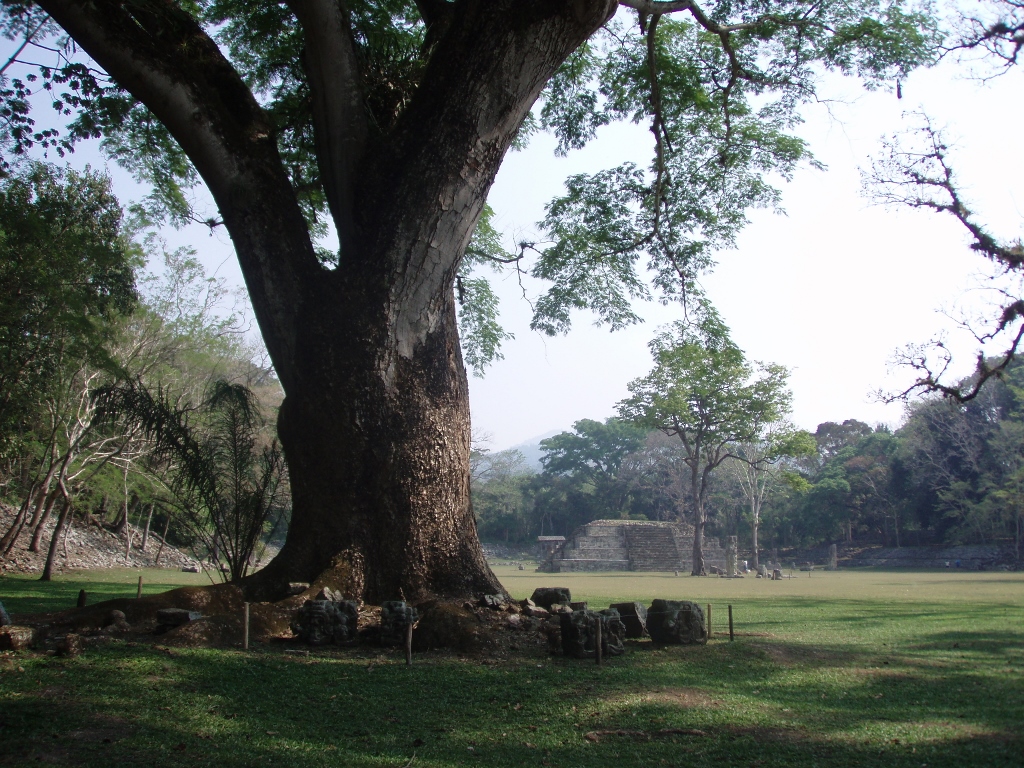 View at the Grand Plaza
View at the Grand Plaza
Again, I was delighted with these powerful trees and near a ceiba that grows beside the path I walked on I saw a couple of stone skulls, standing there as obviously the researchers had not found a better place for them. In the photo it is also possible to see how the trees growing here practically destroy the former structures. By the way, the ceiba or the kapok tree (Ceiba pentandra) is the holy tree of the ancient Maya.
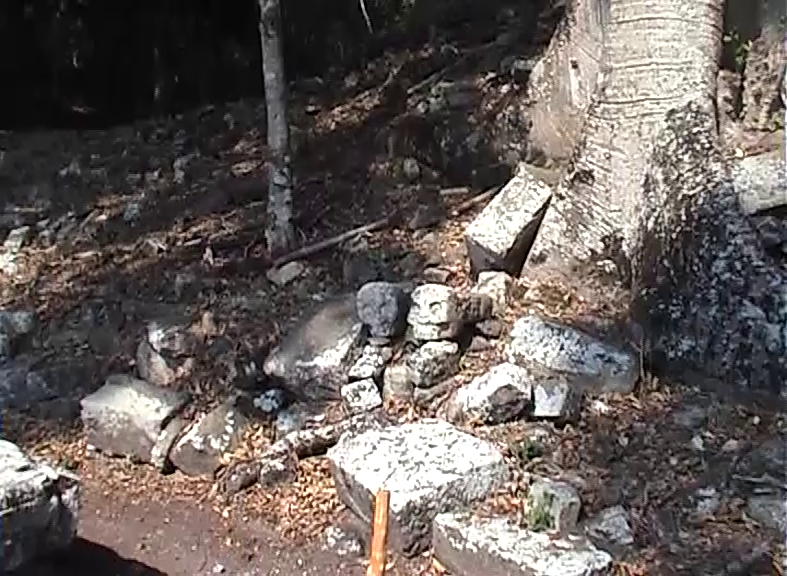 The path, the skulls (in the middle), the ceiba and scattered stone blocks
The path, the skulls (in the middle), the ceiba and scattered stone blocks
Soon I reached the top of Structure 11 and from there I had a fantastic view at the Ballcourt.
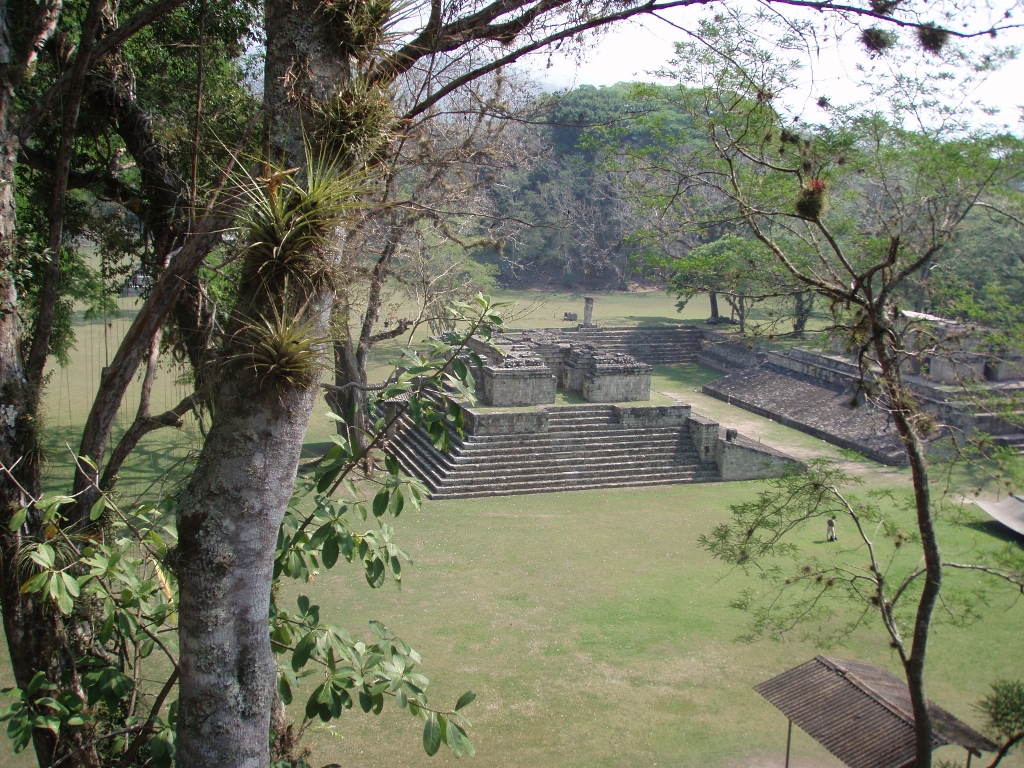 Ballcourt: the left part is Structure 9 and the right one is Structure 10
Ballcourt: the left part is Structure 9 and the right one is Structure 10
The path I followed and the steps made along it were not naive at all for they were quite steep and the air humidity was high although it was still early in the morning. Still, from time to time I felt a light breeze and so I would cool down a little. While I was catching my breath, I could admire some ideograms that adorn one of the walls of Structure 11 that one comes across first.
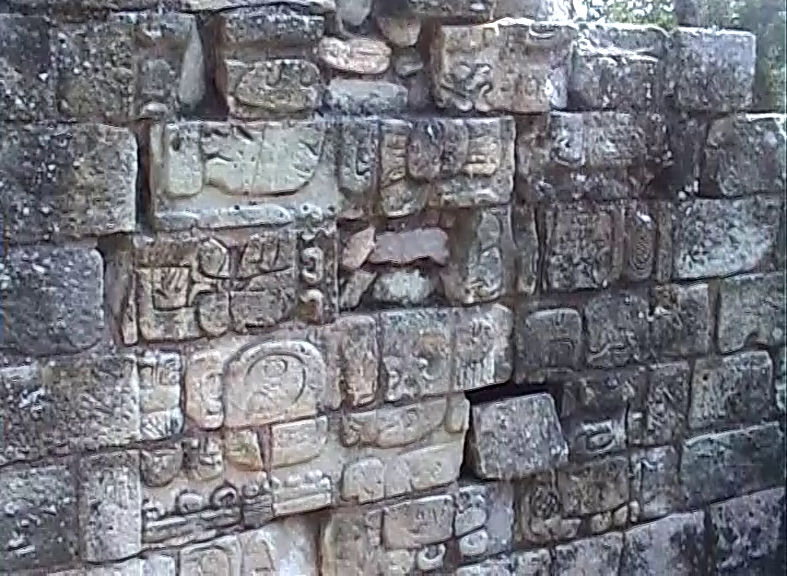 Wall that is a part of Structure 11
Wall that is a part of Structure 11
Structure 11 in the shape of a slightly crumbly pyramid that has a rectangular ground plan which is seen in Copán nowadays was created as a result of the addition of a superstructure which was built by the 16th ruler of Copán Yax Pasaj Chan Yopaat or Yax Pac for short or First Dawn. He ruled Copán from 763 until 810. As opposed to his predecessors, this ruler did not erect monumental steles, opting instead to develop and add onto the structures that were already there. Thus, in 769, using the principle which the ancient Maya people applied regularly, and that was building of a superstructure over the already existing one, he had a platform built over the then temple and above, as it is presumed, the grave of his direct predecessor and then added two more floors there. It was all completed in 773 and nowadays it is called Structure or Temple 11.
The walls of this structure are to a large degree covered in carved ideograms and therefore it is often also called the Temple of the Inscriptions. As one ascends towards the top of Structure 11, it is possible to see the walls decorated in this manner and from one spot there is a superb view at the Grand Plaza, as well as the surroundings. I took advantage of the presence of a guard to ask him to take a photo of me.
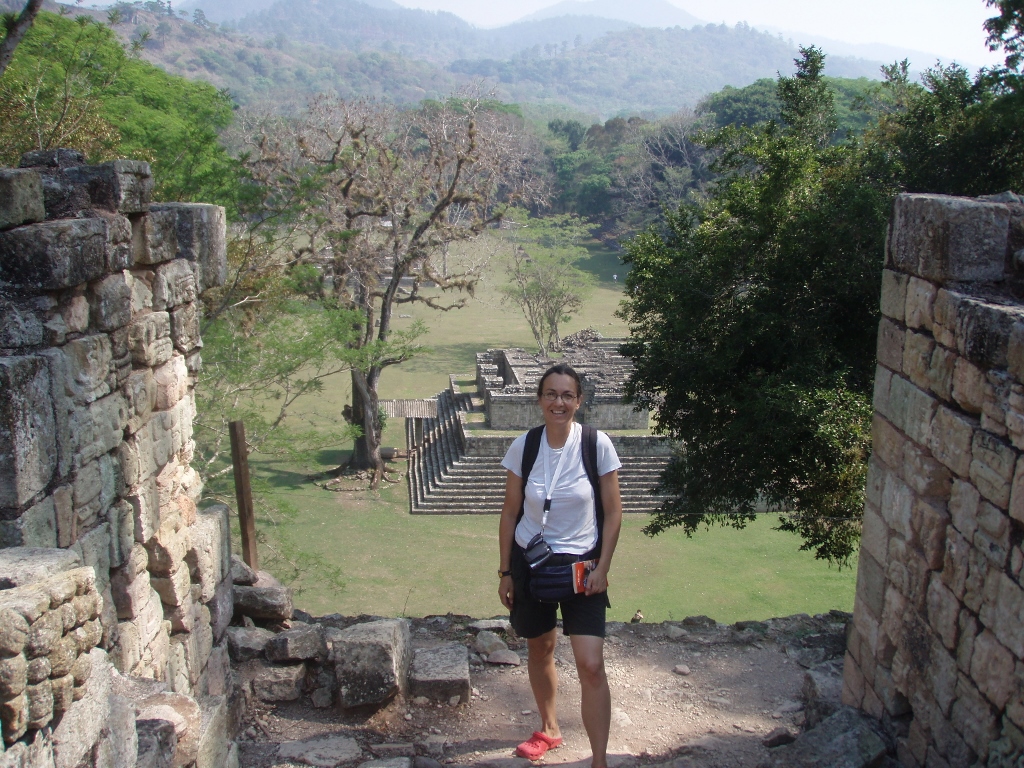 Almost on the top of Structure 11
Almost on the top of Structure 11
And when I got to the very top of Structure 11, which seemed to me as if it were the highest point in Copán, again there was a great view at the Grand Plaza and the surroundings. Some researchers believe that the royal palace of ruler Yax Pac used to be here, while some others think that this was one of the holiest places in Copán from where the ruler could participate in the ceremonies that were taking place in the area of the present-day Grand Plaza that was completely paved then. This would not be difficult at all, since the residents of Copán already had a major problem with deforestation at the time, so it is certain that the ruler had a better view and it would also be easier for him to be seen by his subjects than what may appear today on account of the large trees seen in the photo below.
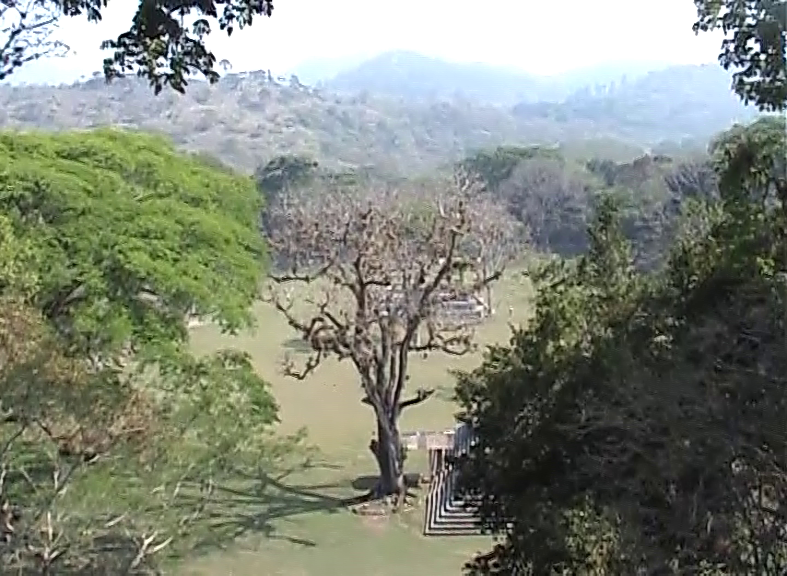 View from the very top of Structure 11
View from the very top of Structure 11
On the one side of Structure 11 there are the Court of the Hieroglyphic Stairway, Ballcourt and Grand Plaza, while on the other side there is the West Court which I reached a little later since I followed the sightseeing route suggested by my guidebook. As opposed to the Grand Plaza that is flat and mostly contains steles, the part of the archaeological site that starts with the Ballcourt and includes Temple 26 with Hieroglyphic Stairway, Temple 11, two large courtyards called the East and the West Courts, as well as numerous other structures and temples elevated around these courtyards is called Acropolis and in a way it has numerous levels, so a visitor constantly goes up and down here. This part constituted the very centre of Copán and it also incorporated the royal complex.
When one continues from Structure 11 following the path for visitors, one descends slightly towards Structure 22A, which I actually mixed up with Structure 22 that is adjacent to the former and at the same level that is elevated on the north side of the East Court. When reading about some important doorway that is a part of Structure 22, I thought that this was what can be seen in the following photo. It is not.
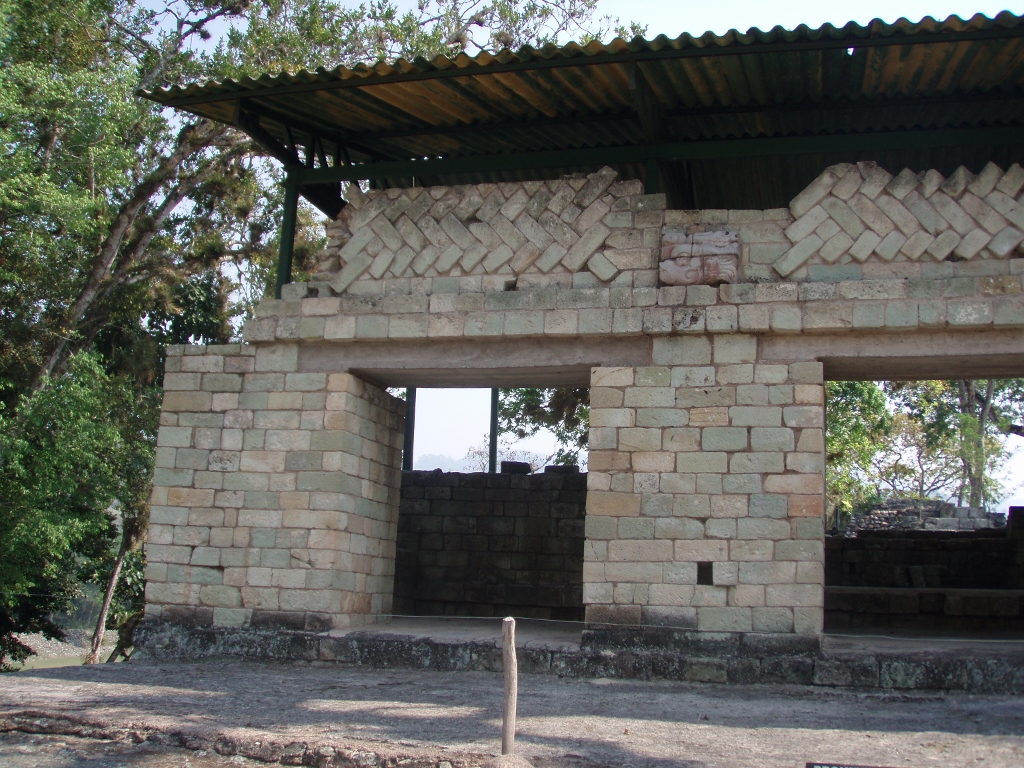 Structure 22A
Structure 22A
Still, Structure 22A is also considered important, for this is a type of structure called “popol nah.” This term denotes a specific type of building that existed in the centre of Mayan cities and that served as the place where men would gather up for counselling.
I truly regret that I did not see for myself that doorway at Structure 22, but while looking around from the point from which I took a photo of a section of Structure 22A, I noticed on the corner of another structure (and that one was Structure 22) depictions of rain god Chaac.
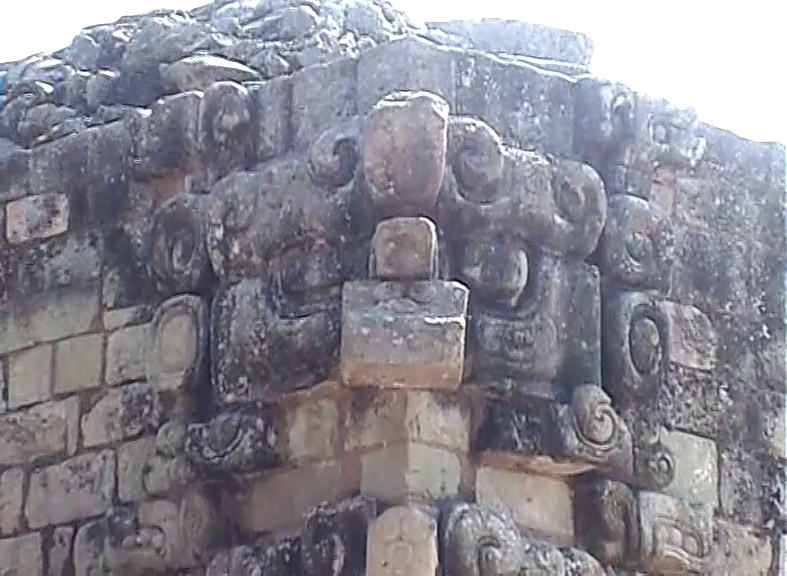 God Chaac on the corner of Structure 22
God Chaac on the corner of Structure 22
Thinking that I had seen all that there was at the level on which I currently was, standing on the top of a large staircase I focused my attention on the East Court that was directly in front and below me.
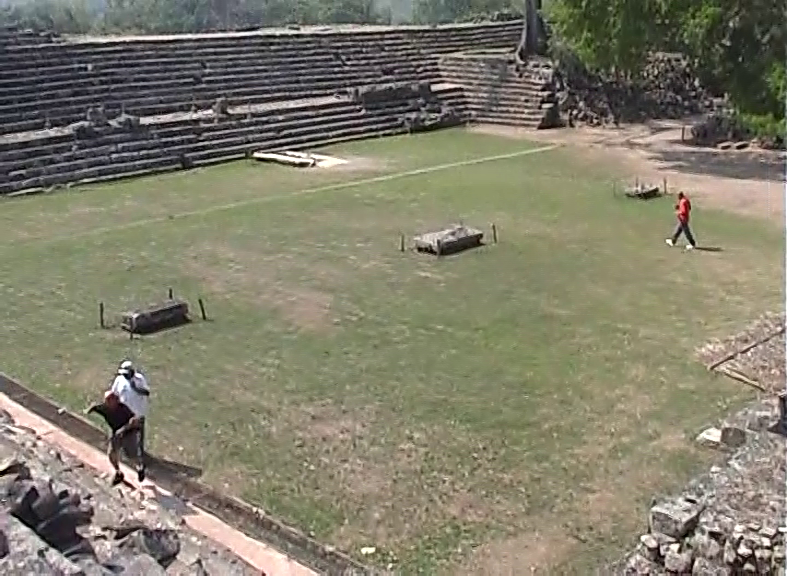 East Court
East Court
From the place at which I was standing, I could also see quite nicely Structure 16 in the shape of a stepped pyramid which concurrently constitutes the east side of the West Court that I planned to visit later on.
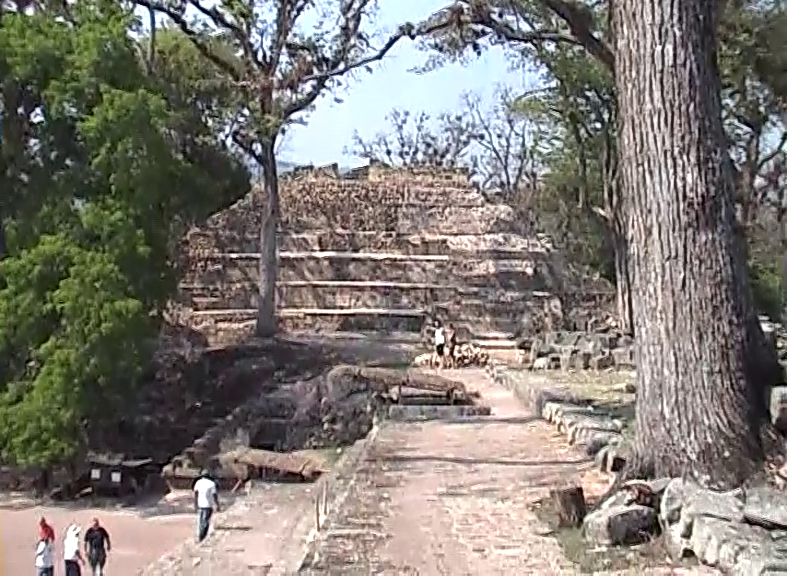 Structure 16 and a small part of the East Court to the left and below
Structure 16 and a small part of the East Court to the left and below
I descended to the East Court down the stairs that are on the north side, primarily in order to see the Jaguar Staircase better.
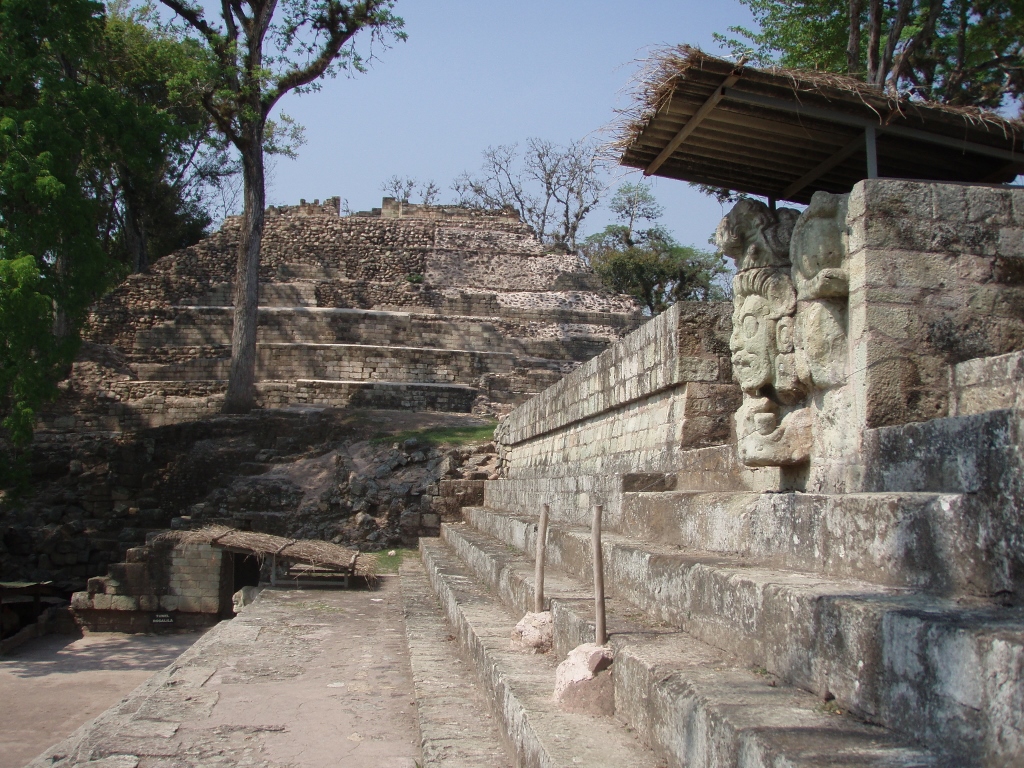 Part of the Jaguar Staircase and Structure 16
Part of the Jaguar Staircase and Structure 16
The reason why this staircase is named like this are the two carved jaguar depictions that adorn this staircase at the level of the East Court. In the middle of this staircase that is on the west side of the East Court there is a depiction of the Sun and it can partially be seen on the right-hand side of the photo above.
Both the depiction of the Sun and the two jaguar depictions are canopied in order to reduce the impact of heavy rains that come by this region regularly.
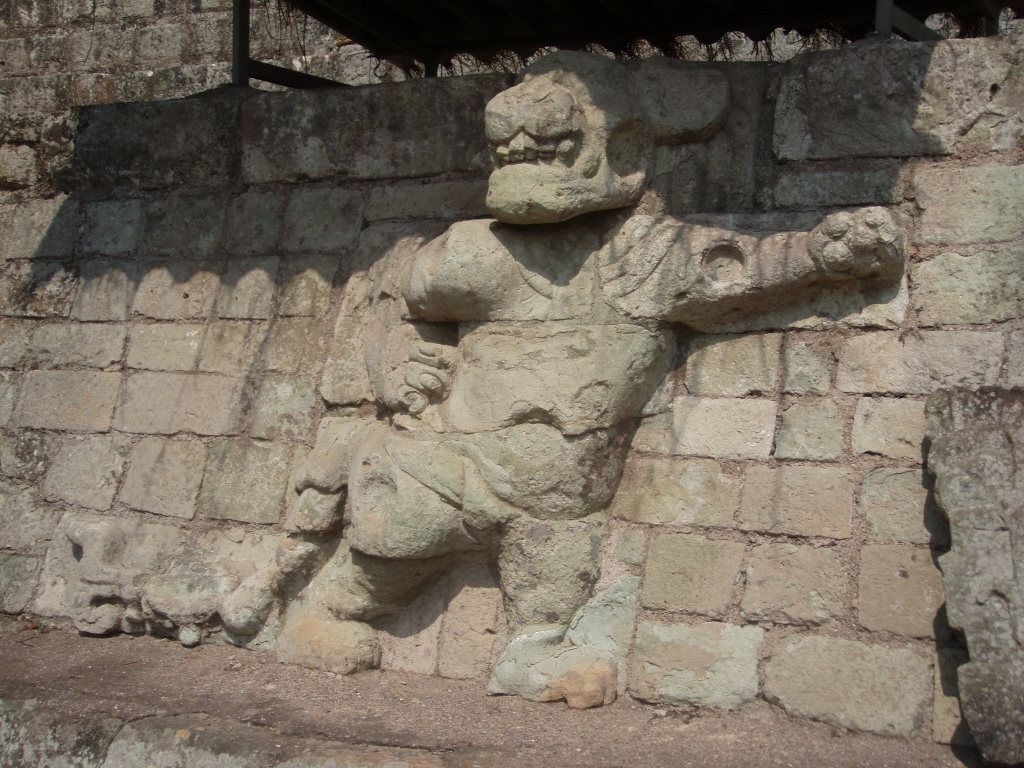 Jaguar at the East Court
Jaguar at the East Court
By the way, from the East Court it is possible to enter a couple of archaeological tunnels leading under the Acropolis. These are the tunnels made by archaeologists in order to enter the interior of the structures. One is the Jaguar Tunnel, 700 metres long, and it leads along the foundations of Structure 22, while the other is called the Rosalia Tunnel and it is significantly shorter leading along the foundations of Structure 16.
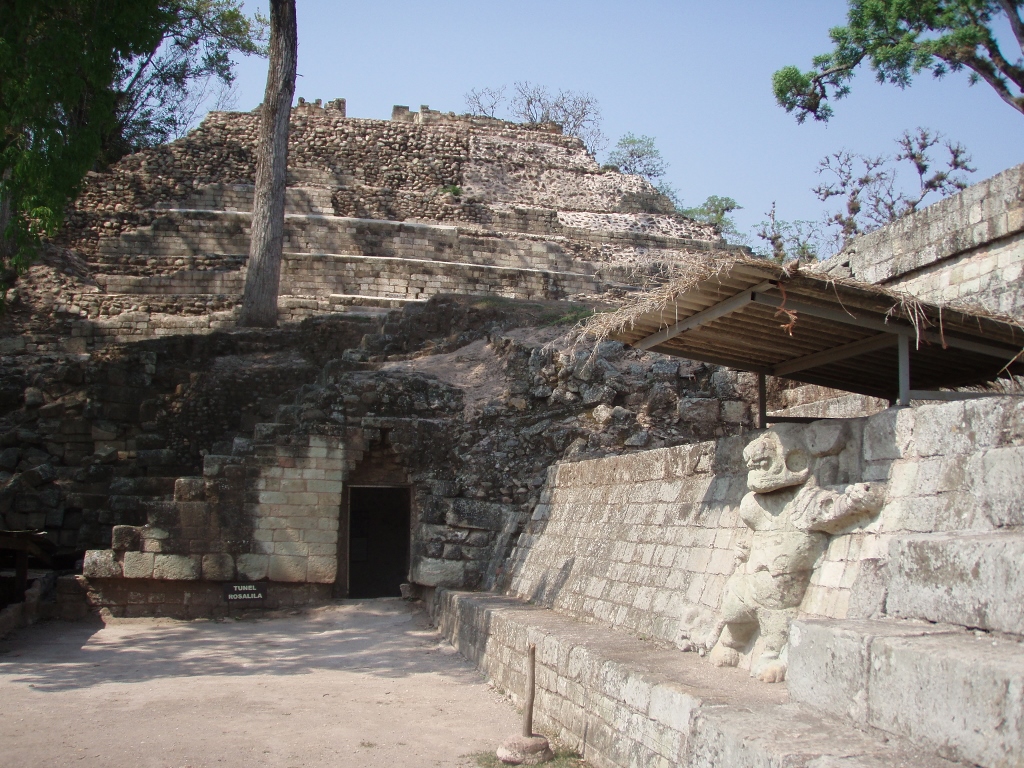 Entrance into the Rosalia Tunnel at the bottom of Structure 16, while a jaguar sculpture is on the right-hand side
Entrance into the Rosalia Tunnel at the bottom of Structure 16, while a jaguar sculpture is on the right-hand side
This other tunnel, the Rosalia one, leads to a small temple that is located at the bottom of Structure 16 and that is completely preserved (its replica painted in lively colours can be seen at the Museum of Sculpture in Copán). In addition to the fact that at this point in time I had still not mastered an EXTREMELY important lesson which I learned a few days later in Tikal, Guatemala, I must admit that I felt quite hot at this time and could not even imagine entering some tunnels that were bound to be too narrow and small for me, where I would lack fresh air. Then again, when I think of Structure 22 and the Rosalia Tunnel, I believe that I would perhaps have to go back again to Copán. Although I have certain doubts about it.
Be as it may, I bumped into Ana and Angela, two Honduran women with whom I arrived by the same coach in Copán Ruinas the previous day. It was a very cordial encounter, as if we had known one another from before, so we hugged and kissed. This situation reminded me of something similar that I experienced in the canyon of the Colca river in Peru (https://www.svudapodji.com/en/south-peru-peru-and-bolivia-summer-of-2005-part-2-2/). No matter how superficial such encounters are, they are essentially so wonderful and reflect in such a fine way the essential closeness of human beings on this wonderful planet. It’s a pity there is not more of the same thing. So, after some chatting and sharing of impressions, I asked them to take a photo of me by one gorgeous tree.
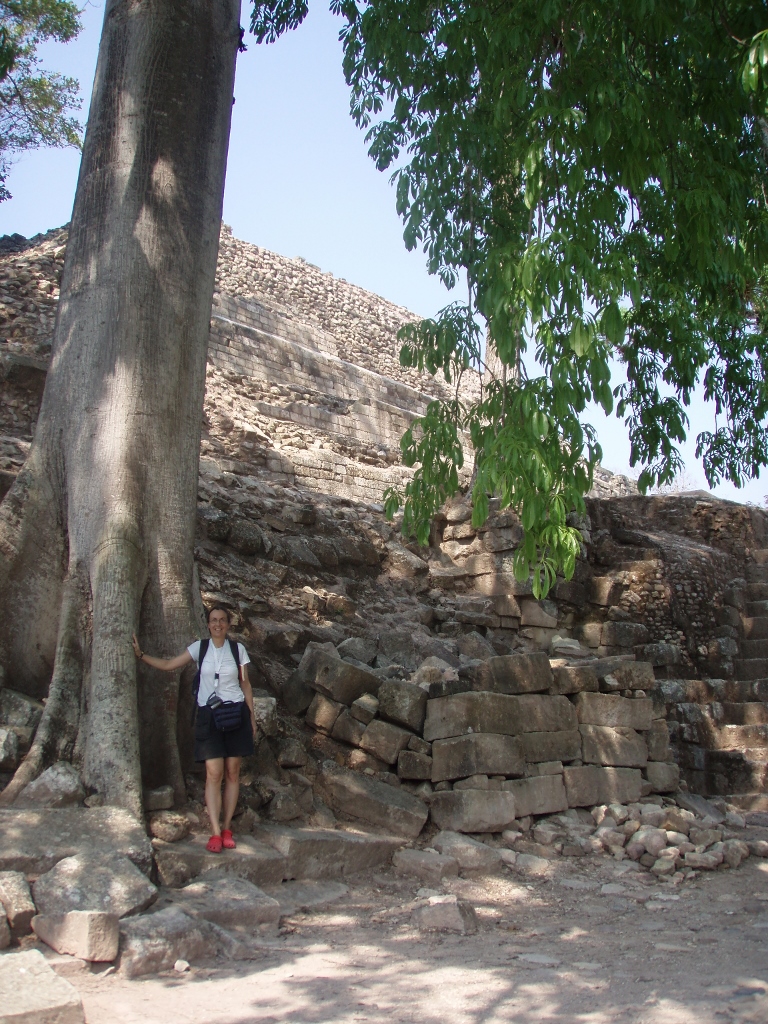 A ceiba tree at the bottom of Structure 16
A ceiba tree at the bottom of Structure 16
When we parted, I hanged around the East Court for a short while yet and so with my video-camera I did catch a glimpse of Structure 22 a little farther away where it is even possible to see the doorway.
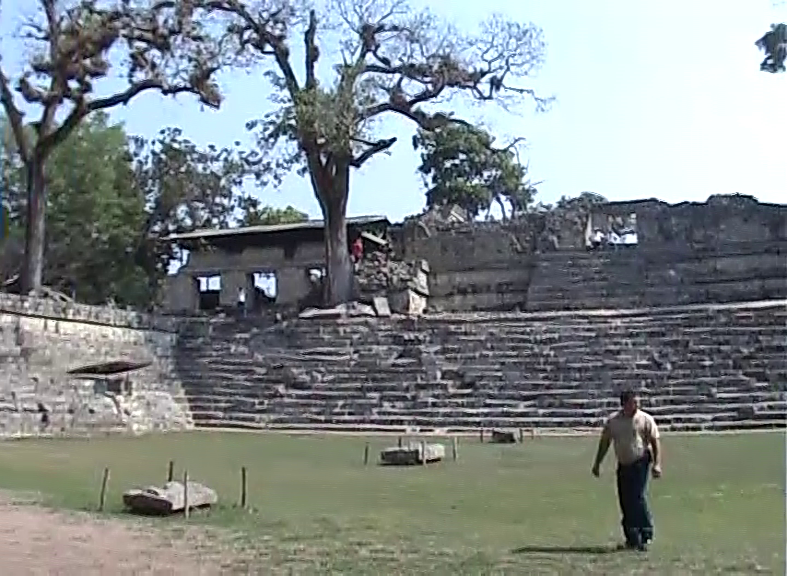 East Court: on the top of the north staircase from left to right there are Structures 22A and 22 (the “hole” is the doorway I’ve been talking about)
East Court: on the top of the north staircase from left to right there are Structures 22A and 22 (the “hole” is the doorway I’ve been talking about)
In the past, the Copán river flowed right east of the East Court and over time it significantly eroded away parts of the city, that is, the structures that were located in that section. For this reason, the riverbed was moved a little during the 1930’s and nowadays there is no longer a threat on that side.
After the East Court, I made a circle along the perimeter of Structure or Temple 16 which in fact is the highest structure in Copán. At its northeast corner there is the East Court, while the West Court is located on the west side of Temple 16. Temple 16 was dedicated to the founder of the dynasty named Kʼinich Yax Kʼukʼ Moʼ or the Great Sun, Quetzal Macaw the First. The temple was built over the original palace and the tomb of the founder of the dynasty. In order to get to the original structure, like in the case of many other structures in the Maya world, here too there are several structures, platforms, temples and tombs that are all situated underneath of what is seen today. As a part of my sightseeing, I reached the south side of Temple 16 from which there was a fine view at some of the structures and plazas that belong to the Cemetery Group.
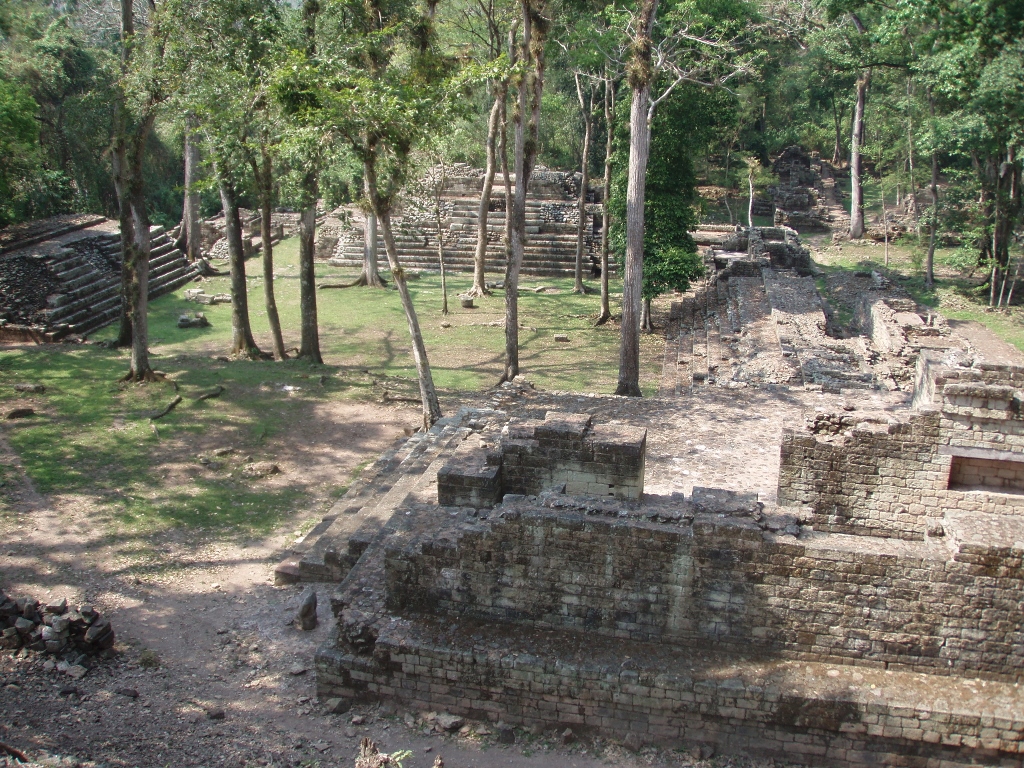 Part of the Cemetery Group: Structures 29, 30, 32 and 33
Part of the Cemetery Group: Structures 29, 30, 32 and 33
As there were very few people here, I could hear the sounds made by different birds and some of them I could even see. Not from up close and not well enough to take a photo of them, but the nature around me was quite alive and I quite enjoyed this.